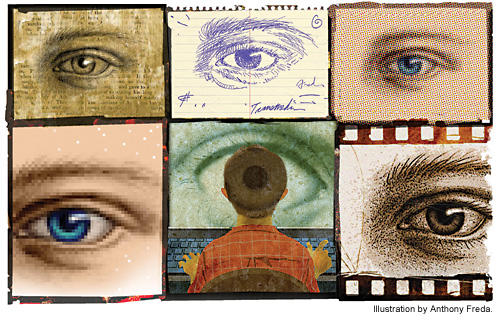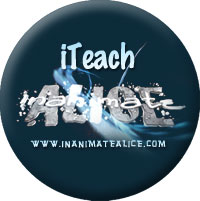By Peter Gutierrez

When Andy Plemmons, a progressive media specialist at David C. Barrow Elementary in Athens, GA, was asked to help create a set of interdisciplinary lessons for fifth graders to learn about September 11, 2001, he naturally took a transmedia approach.
Plemmons remembers turning to TV, radio, and the Web to try to find out what was going on that day. Later, he sought magazines and newspapers, and eventually history books as he tried to process the magnitude—and meaning—of the worst terrorist attacks on American soil.
When it came to teaching his young students, some of whom weren’t even born at the time of the tragedy, Plemmons knew the impact of 9/11 couldn’t be captured by a single account—or even a single medium. He read aloud to his fifth graders Maira Kalman’s nonfiction picture book, Fireboat (Putnam, 2002), about the heroic role of the John J. Harvey that day, and had them watch video clips of the actual fireboat pumping water. In computer lab, kids followed a pathfinder, or a guide to locating online resources, that included photo galleries, primary-source newscasts, personal accounts, and time lines.
They read how children and others experienced that painful day, and, at key points along the way, they contributed their own writings and drawings to create a complete story about the events, Plemmons explains.
His students had no idea they were engaging in transmedia, a way of telling a story or an experience across various platforms, or that they were exercising their “transliteracies” by processing information from multiple media to gain a fuller understanding of what took place that day.
Transmedia isn’t just a new buzzword that belongs to academics or high-priced media consultants. It’s a form of, and an approach to, storytelling that boasts a range of potential curricular applications that applies to literacy and the content areas. Teaching with transmedia guides students through various media formats to provide an immersive experience that makes any topic or narrative more vivid and personal.
Getting started isn’t as daunting as it seems. Whatever challenges there are to using transmedia in schools probably stem from its open-endedness, the same thing that makes it adaptable to teaching a vast range of texts and skills, not to mention every grade level. It’s this flexibility that allows pop culture creators (think Disney’s “High School Musical” franchise) to tell cohesive, if occasionally sprawling, stories across multiple media. But whether students engage with transmedia in classrooms and libraries or at home (as creators or audience)—certain transliterate questions like these come into play:
• Where does the story start? Where and how is it continued?
• Does it need to start in a single place? Or is it possible to retell an opening “chapter” from a different character’s perspective, or go back and add a prequel?
• How do I know which medium comes next as I “read” the story—or does the story need to be told in a linear sequence? Can readers dip into it at different points of their own choosing?
• Can you expand on backstories, or tangential histories? What about adding incidents that fill in gaps in the existing narrative?
• How are similar bits of information or story elements expressed in different media? (In Plemmons’s September 11 project, this might involve a victim’s name mentioned in a newspaper account and then making that person more dimensional and individualized in a homemade video.)
• Why is a particular medium used to convey a certain section of the story? What can one medium accomplish that another can’t?
• How do all media components complement one another and provide a richer audience experience?
• How does the overall experience immerse the audience in a story?
If you’re new to transmedia, these questions might help you get started. If you’re already using it in lessons, you can add your own—and have your students chip in, too. After all, they might already have far more experience with transmedia than you think.
Marsha Kinder first coined the term transmedia in her 1991 book about children’s media, Playing with Power in Movies, Television, and Video Games (Univ. of California Pr.), and it picked up steam when Professor Henry Jenkins, then at MIT and now at the University of Southern California, published an article in 2003 called “Transmedia Storytelling,” in which he argued that readers would find fictional characters more compelling if they migrated from novels and movies to video games. The idea was that things like games, toys, and comics weren’t disposable or ancillary to a core story on the screen or in a book. Instead, since media such as video games were becoming so sophisticated, their core narratives could be distributed across different platforms. Want to learn more about Buffy the Vampire Slayer after the seven-season TV series ended? No problem, just read the comic-book series “Season Eight,” which picks up where the show left off.
It’s no surprise that Jenkins, who had written about Star Trek fandom, became a leading proponent of transmedia’s possibilities. Although unintentional, Star Trek’s creators engaged in transmedia when they took pains to establish continuity between its original TV series more than 30 years ago and ended up with a franchise that includes feature films, an animated series, games, novels, toys, and even a themed attraction in Las Vegas.
In recent years, as public librarians and media specialists have discovered transmedia’s engagement factor—through popular series such as “The 39 Clues” (Scholastic)—they’ve also begun to realize its  teaching potential. Laura Fleming, a K–6 media specialist at New Jersey’s River Edge Schools, encouraged her students to create their own “storyworld” (a fictional universe that exists over more than one medium) to accompany Newbery Medal–winner Paul Fleischman’s powerful picture book Weslandia (Candlewick, 1999) , which deals with bullying and the healing powers of the imagination.
teaching potential. Laura Fleming, a K–6 media specialist at New Jersey’s River Edge Schools, encouraged her students to create their own “storyworld” (a fictional universe that exists over more than one medium) to accompany Newbery Medal–winner Paul Fleischman’s powerful picture book Weslandia (Candlewick, 1999) , which deals with bullying and the healing powers of the imagination.
Fleming’s students were already familiar with transmedia when they read Inanimate Alice, a digitally born episodic story set in the early 21st century, told through sound, images, music, and games, that has become something of a landmark with educators (get a free lesson plan). Excited and inspired by a story that appealed to their various senses and literacies, students set out to craft a more fleshed-out tale for the protagonist, Wesley. They created a Facebook page for him, which allowed Fleming to teach the skill of characterization “invisibly” as readers turned into writers who posted status updates for the fictional character. The book also helped spark creative responses, as students in music class composed original pieces to accompany certain passages in the novel where Wesley plays his own song on a flute.
“Transmedia offers educators a gateway into understanding the fundamentals of storytelling by allowing young people to come to the canon by means of the story forms to which they respond the most,” says Nick DeMartino, a leading media consultant. “Long before the terminology was introduced, teachers found that students often responded more deeply to fictional works by means of the film adaptation. Today we can tell stories—albeit differently—in many different media, powering a new form of ‘comparative literature.’”
What’s the relationship between transliteracy and transmedia? Simply put, transmedia is the result of transliteracy, which is a larger concept and one that can be applied to the more old-fashioned book vs. movie approach, where different media are established as oppositional, not complementary. Remember, with transmedia we’re not talking about a property that can be appreciated solely through a single  medium. When the film version of Suzanne Collins’s The Hunger Games debuted in March, it wasn’t transmedia—it was the same story told in a new medium, not a different part of a story that could only be appreciated across various media. However, when Scholastic authors such as Patrick Carman encourage reluctant readers through their cross platform storytelling, it represents transmedia in its clearest, most inviting sense.
medium. When the film version of Suzanne Collins’s The Hunger Games debuted in March, it wasn’t transmedia—it was the same story told in a new medium, not a different part of a story that could only be appreciated across various media. However, when Scholastic authors such as Patrick Carman encourage reluctant readers through their cross platform storytelling, it represents transmedia in its clearest, most inviting sense.
“We accept that children perceive media in an integrated way, as a seamless experience, and it has been shown that learning is enhanced by multiplatform activities,” says Fleming. Although she blogs insightfully on transmedia at EdTech Insight, Fleming is quick to point out that the pedagogy of transmedia is itself not inherently tech-dependent. In fact, she’s an advocate of students and educators creating transmedia extensions around traditional texts. These can include low-tech options and even extend into real life. Fleming did this in her Weslandia project by having students perform skits and make up games in their physical education class.
Still, there’s no denying that as technology develops, so does transmedia and the immersive experience it provides. Take for example, Bravo’s popular Top Chef series, which last year boosted its audience via a supplemental Web series and direct fan-and-cast interaction on Twitter. With such devices, the audience followed a parallel text and broke through the fourth wall to participate more personally with the show.
When done thoughtfully, transmedia isn’t about exploiting trendy new platforms or growing additional revenue streams for greedy content producers. Rather, it allows participation in a narrative in powerful and original ways. This kind of transmedia doesn’t show up as a flashy add-on to curriculum, but it becomes a streamlined way to embed media literacy and technology literacy.
Want additional examples of projects and assignments that you can easily adapt to the books and other media you’re teaching? Consider these central questions when engaging in group discussions or individual or team-based writing/research projects:
• Should certain media extensions be considered canon? Have students write a persuasive essay or engage in a spirited debate on the merits, or lack thereof, of a favorite text’s media incarnation.
• What do creators do better in a particular medium, and how do they compensate for limitations in others?
• What does a reading reveal? Have students take detailed notes to determine how a given transmedia technique works with the narrative. Does it supplement a more compelling narrative strand by providing the backstory of a secondary character or does it fill a crucial story gap?
• Improve an existing story by authoring transmedia fan fiction. Take a piece of engaging fiction without a film adaptation, such as Garth Nix’s “The Keys to the Kingdom” series, and script an original movie scene that makes explicit an incident that the original text only implied or alluded to.
You don’t have to be a transmedia expert to incorporate it into your teaching. Comparing and contrasting modes of storytelling between different story forms is a great way to help students understand character, plot, action, scene, and theme. Perhaps most intriguingly, transmedia—and the excitement around it—points to the changing roles of media specialists, libraries, and reading itself. Fleming says it best.
“As a school librarian, I feel I have a responsibility to teach my students how to read and write across media and to provide a learning environment that allows for the freedom to think about story in less conventional ways,” she says.
When we approach transmedia storytelling with this kind of thoughtful pedagogy, and treat fiction and nonfiction texts as more “spread out,” then it’s clear that transmedia isn’t an enemy of reading and writing. Instead, it represents a new way of fulfilling one of literacy’s most inspiring promises: it expands the reader’s world.
Author Information
Peter Gutierrez (fiifgutierrez@gmail.com), a former middle school teacher, has written about pop culture for the past two decades. His SLJ blog, “Connect the Pop,” explores transliteracy, pop culture, and critical thinking.



Excellent post. I’m writing from Spain so be patient if I make some written mistakes. I enjoyed reading your post, I’m teacher and now I’m discovering all the world related to transmedia, I’m very interested in trying to introducing all this methodology of teaching in my classes. Your article has developed different ideas about hor working at the class in English as Second language. THanks a lot and if it coulb be possible I would like to get more information and experiences in order to learn how to get my aim.